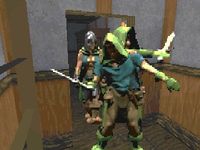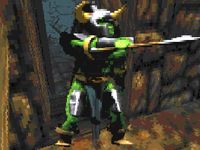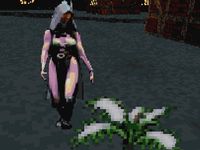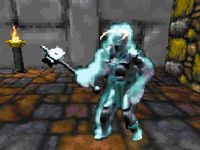Daggerfall:Bestiary
This bestiary provides an overview of the creatures in Daggerfall. Some notes:
- "Higher levels" generally refers to level 14 (at least) and higher. However, it is possible to encounter the more dangerous foes as early as level 6.
- All monsters of a particular type have the same level throughout the game. This means rats are always level 1 enemies and Ancient Liches are always level 21. Aside from its role in selecting the random dungeon inhabitants, an enemy's level is relevant if it is a spellcaster, since the magnitude, chance, and duration of spells are determined by caster level.
- An enemy's skills also depend on its level. The value of any skill will always be five times the enemy's level plus a starting value of 30. For example, a level 20 enemy or higher has all skills at 100, a rat all skills at 35. For non-humanoid adversaries, skills in the six schools of magicka can never surpass 80.
- The fighting strategies for each creature contain recommendations based on Daggerfall gamers' personal experiences. In general, Spell Reflection, Resistance, and Absorption are very useful when fighting any monster able to cast spells. It would be worth your while to invest in these spells, or in items which can cast them.
- If a certain material is required to damage a monster, weapons of lower quality will not harm it—even if they are enchanted. When it comes to weapons only the material is crucial, not whether it is an enchanted weapon (unlike in Morrowind or Oblivion).
- Humanoid enemies and some monsters are associated with a language skill which may prevent them from attacking you unless provoked (attacked or pickpocketed) if your own skill in this language is sufficient. The chance to tame these enemies can be calculated according to these formulas:
-
- Monsters:
(player's language skill + (player's personality ÷ 10) + weapon status) ÷ 200- Humanoids:
( (player's personality ÷ 5) + (player's etiquette skill ÷ 10) + weapon status ) ÷ 200
- Weapon status: +10 sheathed, -25 drawn
- Every non-humanoid enemy has a characteristic noise (click the associated sound files to hear them). Quite often, a creature can be heard long before it can be seen, so by recognizing the sounds you can prepare for what awaits you in the darkness ahead. It may also make the task of finding your quest target a lot easier.
- For detailed listings of where specific foes may be encountered, see enemy spawn locations.
Creature Types[edit]
Animals[edit]
Animals are mundane creatures (or oversized versions of them). They never carry any treasure, though you may still retrieve arrows from their corpses. Certain animals are carriers of disease. No special materials are required to harm animals.
-
-
- Animals: Giant Bat • Giant Scorpion • Grizzly Bear • Rat • Sabertooth Tiger • Slaughterfish • Spider
-
Passive Animals[edit]
These pose no threat to anyone and can't be harmed by the player, and are most commonly found in towns.
Monsters[edit]
Monsters are fantastical creatures, often possessing various magical abilities. These can range from magical attacks to various magical resistances, and many monsters can only be harmed by weapons made of special materials. All monsters have an associated language skill. Also, unlike animals, you can find some treasure on the corpses of most monsters.
Humanoids[edit]
In addition to fierce beasts and deadly monstrosities, humanoid foes are often encountered throughout the Iliac Bay. Humanoids always have the same level as your character and they can be fairly dangerous at higher levels. If your character level rises during a quest or while in a dungeon, humanoid foes that are already generated—be it as quest adversaries or random dungeon inhabitants—will not rise in level. They will remain at the same level as your character when you accepted the quest or entered the dungeon. Humanoids carry equipment like orcs, and fall into three categories:
- Warriors: heavily armored, and use ranged attacks at a distance.
- Mages: have the ability to cast spells.
-
-
- Battlemage • Healer • Mage • Nightblade • Sorcerer
-
- Thieves: lightly armored and often attack rapidly, also use ranged attacks at a distance.
Spells Available to Humanoid Spellcasters
The following table lists the spells used by humanoid spellcasters (with the exception of sorcerers). The selection of available spells depends on the spellcaster's level, which as mentioned above is always the same as your character's level. Note that all spellcasters cast the same spells, regardless of which class they belong to.
| Level | 1 - 2 | 3 - 5 | 6 - 8 | 9 - 11 | 12 - 14 | 15 - 17 | 18 and higher |
|---|---|---|---|---|---|---|---|
| Spells |
The total amount of spell points any enemy (including monsters) has available is calculated as follows:
100 + (Enemy's level × 10)
Orcs[edit]
"From a distance, an orc may resemble a large, squat, muscular man - before the tusks become evident, and the green skin and the piggish eyes are seen. Usually, when a viewer is that close to an Orc, he or she is not taking notes about the details. Orcs are among the most common encounters around the Iliac Bay, particularly around the southern half of the Wrothgarian Mountains. They are a consistently savage group, ready for a fight no matter the odds. Some rather eccentric researchers have suggested that the Orcs have a culture as ancient and sophisticated as ours, and that their seeming mindless barbarity is somehow related to rites of passage or tests of courage. It is highly likely that these researchers have never felt the sting of an orc captain's barbed axe." - Daggerfall User's Guide
Hailing from Orsinium, these warriors can be found across the Iliac Bay. Like humanoids, their spoils include a good deal of equipment.
-
-
- Orcs: Orc • Orc Sergeant • Orc Shaman • Orc Warlord
-
Lycanthropes[edit]
"These cursed creatures are men by day, completely indistinguishable from "normal" men, and savage half-beast predators when the moon is full. At least two lycanthropes are common to the Iliac Bay environs: the werewolf and the wereboar. The werewolf is only found in the woodlands of High Rock and rarely in the jungles of Hammerfell, but the wereboar is found everywhere, and is the more fearsome opponent. Neither seems to be capable of a thought beyond bloodlust, and both are impervious to common weaponry. Their claws are keen as razors and are somehow capable of transmitting the dreaded lycanthropy to those it strikes. While lycanthropy is a relatively simple disease for most temples to treat, few who survive a wereboar attack are likely to do more than be thankful and rest for several days. 'Tis ironic to count your blessings when you have just been cursed." - Daggerfall User's Guide
Two types of lycanthropes exist in the Iliac Bay area—werewolves and wereboars. Weapons of at least silver quality are needed to harm them, though they're not exceptionally dangerous (compared to werewolves in Bloodmoon) and carry no treasure. However, there is always a risk of contracting lycanthropy from combat.
Atronachs[edit]
As in Morrowind, Oblivion, or Skyrim, some of the atronachs in Daggerfall are Daedric in origin.[1] However, some are not daedra, but rather golem-like constructs created by mages in the Iliac Bay.[2] Though they can be hit by any material, they are tied to a certain element and are thus weak to the opposing element. Lastly, they carry no treasure. Ice Atronachs can also be found underwater.
-
-
- Atronachs: Fire Atronach • Flesh Atronach • Ice Atronach • Iron Atronach
-
Due to inconsistency in the game data, Flesh, Ice, and Iron Atronachs can be seen as Air, Water, and Earth ones in certain situations.
Undead[edit]
Undead creatures consist of spirits, reanimated skeletons and corpses, and vampires. They are a recurring menace in dungeons, and some can be very dangerous. Some types of undead are carriers of disease. Most undead are able to detect invisible foes. Ghosts, Skeletal Warriors, Wraiths and Zombies are also often found underwater.
-
-
- Undead: Ancient Lich • Ghost • Lich • Mummy • Skeletal Warrior • Vampire • Vampire Ancient • Wraith • Zombie
-
Daedra[edit]
"The peasants have colorful terms for Daedra: fiends, unclean spirits, the evil ones, the Dark Princes, the gods of torment, the infernal ones, and, most commonly, demons. Those who wish to understand or battle these nightmarish beings, rather than live in fear, prefer the more circumspect term, Daedra. It is nearly impossible to say anything definitive about Daedra, despite thousands of years of scholarship devoted to their nature. Their reputation as cruel, amoral geniuses of destruction seems to be mostly deserved, but if they are true evil, our definition of evil may need revision to include the complexity of their natures. Daedra appear to have a well-organized hierarchy, and the ones found in our world are doubtless the weakest of the lot. Of course, the Fire Daedra, the Frost Daedra, the Seducer, or the Daedra Lord are among the most dangerous creatures in Tamriel, but there is certainly something greater out there in the world they call Oblivion. Perhaps we are already doomed to fall beneath their fire." - Daggerfall User's Guide
"Daedra" is a term for any of the numerous varieties of otherworldly beings from the plane of Oblivion. They are fairly challenging adversaries, and can only be harmed by weapons of mithril quality or greater. All daedra can detect invisible foes.
-
-
- Daedra: Daedra Lord • Daedra Seducer • Daedroth • Fire Daedra • Frost Daedra
-
Loot Tables[edit]
There are a set number of loot tables each enemy can receive drops from.
| Enemy Type | Loot Table | Gold | Armor | Weapon | Magic item | Holy | Book | Misc Monster Ingre | Warm Monster Ingre | Cold Monster Ingre | Misc Ingre1 | Misc Ingre2 | Warm Plant Ingre | Cold Plant Ingre | Clothes |
|---|---|---|---|---|---|---|---|---|---|---|---|---|---|---|---|
| Orc, Orc Sergeant | A | 1-10 | 5 | 5 | 2 | 0 | 0 | 0 | 0 | 0 | 0 | 2 | 0 | 0 | 4 |
| Spriggan | B | 0 | 0 | 0 | 0 | 0 | 0 | 0 | 0 | 0 | 0 | 0 | 10 | 10 | 0 |
| Archer, Ranger, Centaur, Nymph | C | 2-20 | 5 | 25 | 3 | 2 | 2 | 5 | 5 | 5 | 5 | 2 | 10 | 10 | 0 |
| Harpy, Imp | D | 1-4 | 0 | 0 | 0 | 4 | 0 | 6 | 6 | 6 | 6 | 0 | 6 | 6 | 0 |
| Daedroth, Mummy | E | 20-80 | 10 | 10 | 3 | 15 | 2 | 0 | 0 | 0 | 0 | 1 | 0 | 0 | 4 |
| Giant | F | 4-30 | 50 | 50 | 1 | 0 | 0 | 5 | 5 | 5 | 2 | 3 | 2 | 2 | 0 |
| Zombie | G | 3-15 | 50 | 50 | 1 | 0 | 0 | 0 | 0 | 0 | 0 | 3 | 0 | 0 | 5 |
| Skeletal Warrior | H | 2-10 | 0 | 100 | 1 | 0 | 0 | 0 | 0 | 0 | 0 | 0 | 0 | 0 | 2 |
| Ghost, Wraith | I | 0 | 0 | 0 | 2 | 5 | 0 | 0 | 0 | 0 | 0 | 0 | 0 | 0 | 0 |
| Fire Daedra, Frost Daedra | J | 50-150 | 5 | 5 | 3 | 0 | 0 | 0 | 0 | 0 | 0 | 0 | 0 | 0 | 0 |
| Acrobat, Assassin, Bard, Burglar, Rogue, Thief | O | 5-20 | 10 | 15 | 2 | 0 | 0 | 1 | 1 | 1 | 1 | 0 | 1 | 1 | 0 |
| Spellsword | P | 5-20 | 5 | 10 | 2 | 0 | 10 | 5 | 5 | 5 | 5 | 5 | 5 | 5 | 0 |
| Daedra Seducer, Vampire, Vampire Ancient | Q | 20-80 | 10 | 25 | 3 | 0 | 5 | 8 | 8 | 8 | 2 | 3 | 2 | 2 | 35 |
| Dreugh, Lamia | R | 5-20 | 5 | 15 | 2 | 0 | 0 | 3 | 3 | 3 | 5 | 0 | 0 | 0 | 0 |
| Ancient Lich, Daedra Lord, Lich | S | 50-125 | 10 | 10 | 3 | 0 | 5 | 5 | 5 | 5 | 15 | 5 | 5 | 5 | 0 |
| Barbarian, Knight, Monk, Warrior, Orc Warlord | T | 20-80 | 100 | 100 | 1 | 0 | 0 | 0 | 0 | 0 | 0 | 0 | 0 | 0 | 0 |
| Battlemage, Healer, Mage, Nightblade, Sorcerer, Orc Shaman | U | 7-30 | 10 | 10 | 2 | 10 | 2 | 5 | 5 | 5 | 10 | 2 | 5 | 5 | 0 |
Transmitted Diseases[edit]
Some creatures are carriers of disease. The following list details the possible diseases an enemy may transmit.
| Type of Enemy | Animal | Undead |
|---|---|---|
| Disease |
See Also[edit]
References[edit]
- ^ Dialogue in Background Information quest
- ^ Daggerfall User's Guide - description of Imps







